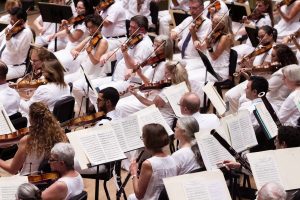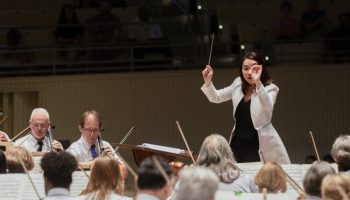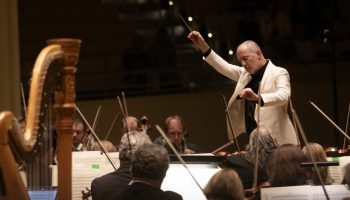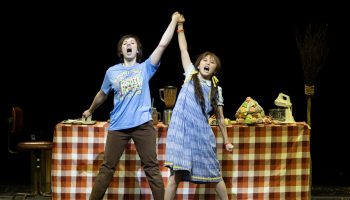



At first glance, tonight’s two pieces have nothing in common. One is a brand-new, world premiere, and the other is a beloved 19th-century classic. But they begin at the same place: the ivory keys of a grand piano.
The Chautauqua Symphony Orchestra and three guests will perform Modest Mussorgsky’s and Maurice Ravels’ famous “Pictures at an Exhibition” — one of the most well-loved orchestral pieces of all time — at 8:15 p.m. Tuesday, July 30 in the Amphitheater. The concert opens with a world premiere of New York composer Jeremy Gill’s “Concerto d’avorio” (Concerto of Ivory). Pianists Shai Wosner and Orion Weiss will share one piano in Gill’s rare “piano-four-hands” concerto.
The two pieces form a striking contrast, according to Guest Conductor JoAnn Falletta, whose many hats include director of the Buffalo Philharmonic Orchestra, director of the Virginia Symphony Orchestra and Principal Guest Conductor of the Brevard Music Center.
“There’s a contrast between an old favorite and something brand-new,” Falletta said. “ ‘Concerto d’avorio’ is completely unknown, completely new and very modern — that’s contrasted by a beloved piece that’s been around since 1874.”
Both pieces, Falletta said, are rooted in piano.
“ ‘Pictures at an Exhibition’ was originally written for solo piano, and ‘Concerto d’avorio’ is tied in every movement to a composer who played the piano,” she said.
“Concerto d’avorio” is a musical study of the piano’s very nature, rooted in ancient stories of deception and ivory. Gill, who wrote the piece as a commission for the Buffalo Philharmonic and Chautauqua Institution, said he was fascinated with Virgil’s Aeneid.
“I love that image from the Aeneid, when Aeneas is leaving the world of the shades and going back to what we consider the real world,” Gill said. “He can go through two doors: one of horn, and one of ivory.”
Gill explained only true dreams can pass through the door of horn, and only false dreams can pass through the door of ivory. But a surprising choice brings Aeneas back to reality.
“But when Aeneas leaves, he goes out through the door of ivory — the door of false dreams,” Gill said.
That puzzling image, Gill said, led him to think about the nature of the ivory-keyed piano — and of the uncommon “piano-four-hands” style, which features two soloists at the same piano.
“The idea is that the piano is always pretending to be something else,” Gill said. “For example, if you have a very fluid, legato-seeming right hand, you’re imitating the voice. In four-hand music specifically, a lot of the repertoire is arrangements or transcriptions of orchestral music.”
Ivory keys, ivory doors — are they deceptive? “Concerto d’avorio” explores the versatile mimicry of piano music through an orchestra, two soloists and one set of keys. The piece’s four movements, Gill said, explore the piano’s mimicry of each part of an orchestra and take inspiration from pianist composers.
Gill said the first movement features “characteristic” sounds from each instrument: fanfares from the brass, melodies from the strings and “windy” scales from the woodwinds.
“You have the orchestra separated very clearly into parts — and the piano imitates all of that,” Gill said. “The piano takes scales from the winds, it plays fanfares like the brass does, and in the middle of the piece, the long string melody is played by the bottom part of the piano.”
Each movement, Gill said, continues to explore the relationship between piano and orchestra. The second movement features only brass, percussion and piano — all imitating ancient instruments and signals. The third movement features strings and piano, both imitating the human voice in song. Every instrument plays in the fourth and final movement, bringing the disparate elements of the composition back together.
The piece’s roots in piano are mirrored in its influences, Gill said. Each movement is inspired by a famous pianist and composer: Franz Lizst’s orchestral piano work, Béla Bartók’s percussive piano compositions, Frédéric Chopin’s graceful melodies and György Ligeti’s complex, machinal pieces.
After opening with “Concerto d’avorio,” the CSO will play one of the most beloved pieces in the orchestral repertoire: “Pictures at an Exhibition,” a powerful retelling of its composer’s love and loss.
Mussorgsky originally wrote the piece for solo piano after the death of his close friend, artist Viktor Hartmann. After Hartmann’s death, Mussorgsky spiraled into a yearlong depression. The composer found no outlet for his grief until 1874, when he attended a memorial exhibition of his friend’s paintings.
Falletta said the piece, which allows listeners to walk through the exhibit with Mussorgsky, is beloved for its musical and emotional power.
“He went to the exhibition and saw all the paintings, and that inspired him to write the piece, … a powerful testament of love and grief,” Falletta said. “There are little sketches, little sections, that are exactly the pictures that he saw from his friend. All of Viktor Hartmann’s paintings are memorialized there; Mussorgsky very lovingly created a musical picture of every painting that he saw.”
Years later, composer Maurice Ravel orchestrated the piano piece, Falletta said.
“It’s the original piano piece, now in dazzling orchestra garb,” Falletta said. “It has become one of the best-loved pieces in the orchestral repertoire.”




